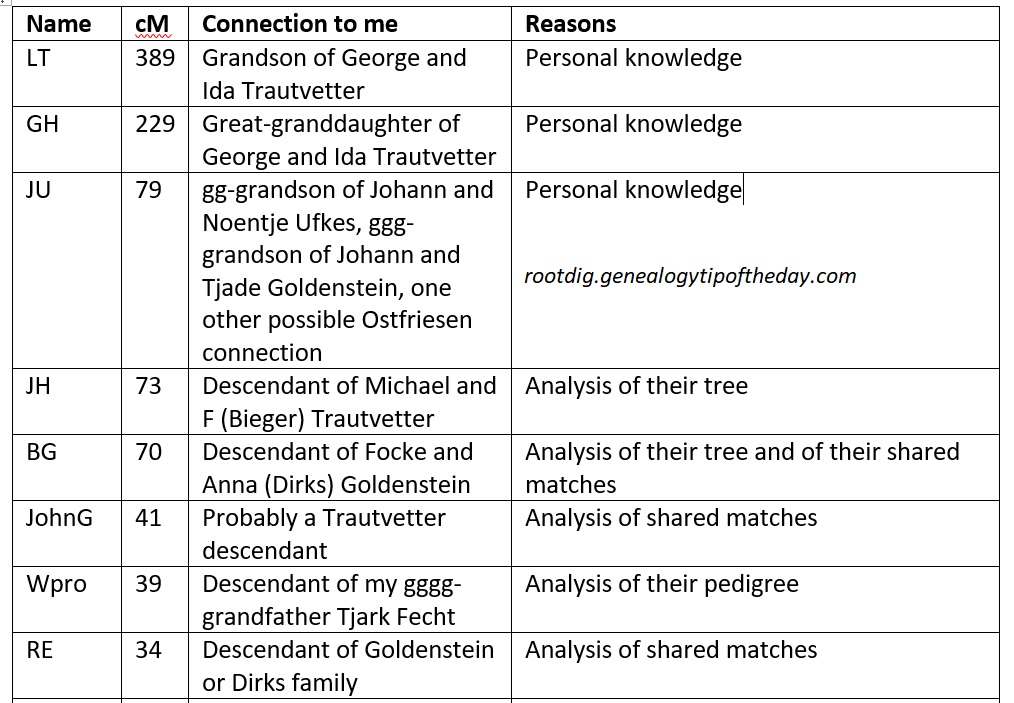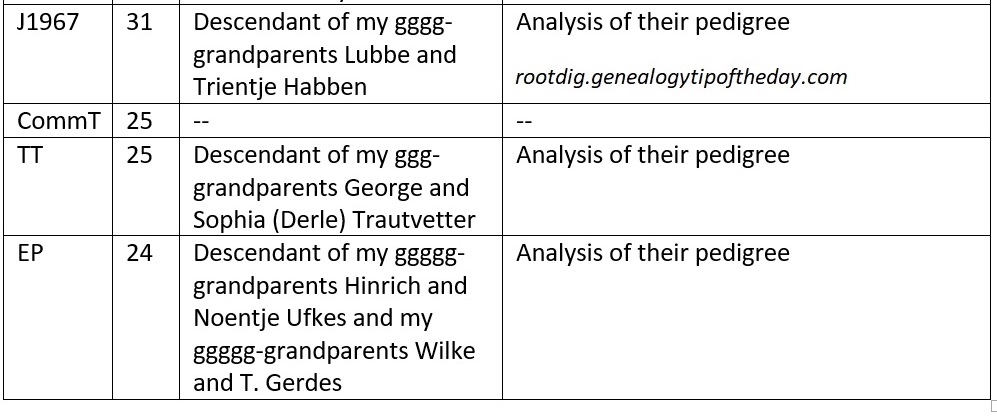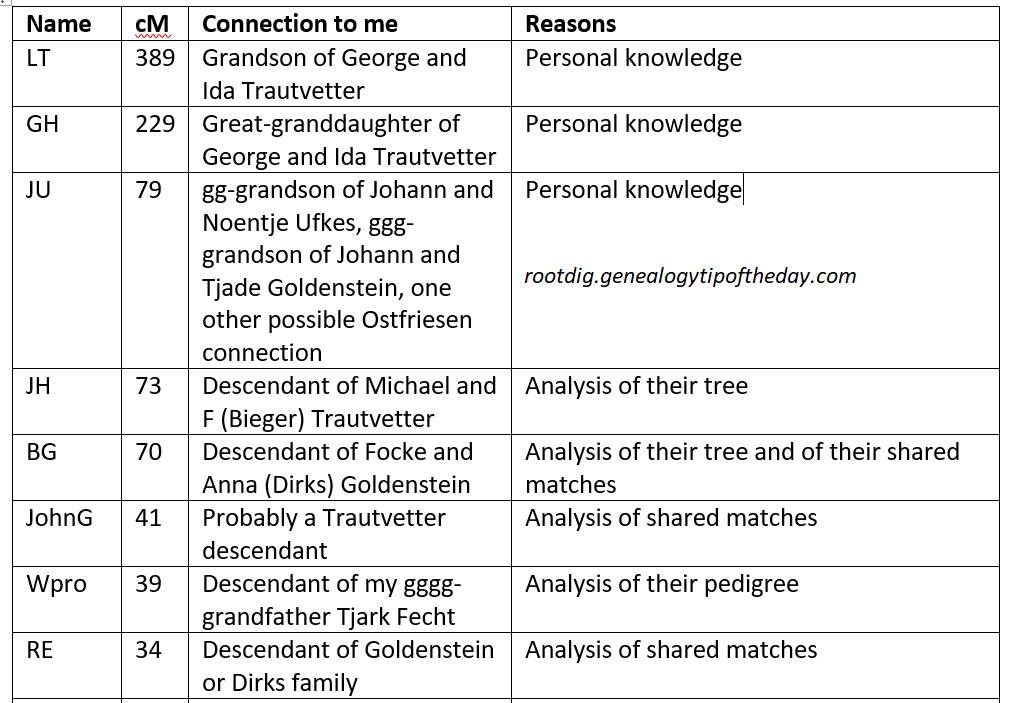It’s always great to determine a DNA match–particularly when it is on a family you’ve been focused on. That’s what happened with a match we’ll call “Jol.” She was a new shared with match with several known descendants of my Trautvetter great-great-grandparents. That’s how I first located Jol–she was a new shared match with a few of my Trautvetter DNA matches that I watch fairly closely.
AncestryDNA indicated that Jol and I shared 22 cM of DNA across two segments and we were projected to be between 4th and 6th cousins. The two shared DNA matches with Jol with whom I share the most DNA are descendants of my Trautvetter great-grandparents.
Jol had the shortest of trees, but armed with her father’s name, death date, and place of death (which she fortunately included), I determined how she was probably connected to me. Her grandmother was a Trautvetter from the same rural area where mine lived and I easily traced that line until I found the connection to Jol. She was a descendant of my 4th great-grandparents, Erasmus and Anna (Gross) Trautvetter. Jol’s great-grandmother and my great-grandfather were first cousins. Problem solved.
This was a good discovery for me personally as I’m trying to sift out the DNA matches to known descendants of Erasmus and Anna’s son John George Trautvetter and grandson John Michael Trautvetter–who are also my ancestors. This is being done in an attempt to sift out DNA matches who may be connected to me through the wives of those two Trautvetter men. My Trautvetter connection is through my paternal grandmother, Ida (Trautvetter) Neill [1910-1994].
But there was a problem.
The shared matches that Jol and I had made absolutely no sense. They were strewn across my family tree with matches to known descendants of three of my four grandparents–not just my paternal grandmother who was a Trautvetter. The other matches (half of them) were descendants of ancestors of my maternal grandparents–neither of whom have a Trautvetter connection at all and both of whom have ancestry that has been completely traced to the 16th century in an area of Germany a significant distance from where the Trautvetter family lived.
I was excited to find a new descendant of Erasmus in my DNA results, but before I used that match for any further match analysis, I needed to stop and take a more detailed look at the shared matches I had with her. One should never let the excitement of having “figured something out” prevent one from looking at all the information available to them. If I ignored the other shared matches with Jol I was in danger of not looking at all the information available to me.
It was time to analyze those matches in more detail. It was also time to analyze Jol’s ancestry in more detail. Jol has other ancestors besides Erasmus Trautvetter. So do I.
I made a chart that summarizes the matches I have with Jol. This chart includes an abbreviation of their username on AncestryDNA (for privacy purposes), our number of shared cM, the matches’ known or probable connection to me (sometimes not as specific as I’d like), and the reasons for the knowledge of that connection. In the interest of space the reason has been shortened and is longer on the copy of this chart I have for my own personal use. It’s important to track how I arrived at the knowledge of this connection as new information or knowledge of other connections may cause me to re-evaluate earlier conclusions.
Fortunately I know how I connect to all but one of these matches to Jol. This does not mean that Jol connects to them in the same way.


The connections to my maternal side (noted by a connection that does not contain the surname of Trautvetter) were all over my maternal side. It was not just one branch of my mother’s ancestry.
Then I remembered. One of the other names in Jol’s tree was the last name of Gerdes. It’s a good Ostfriesen last name and that’s where all of my maternal ancestors were from. I did some more work on that portion of Jol’s tree.
Not only did I share a set of Trautvetter 3rd great-grandparents with Jol, I also descended from at least five sets of her fifth grandparents through Ostfriesen families from the general area of Wrisse. Various marriages in Ostfriesland and migrations to Adams and Hancock Counties, Illinois, resulted in Jol and in me. Our Ostfriesen connections were no closer than these five sets of fifth great-grandparents. They were spread across the lineage of Jol’s grandfather and my mother. It was through that shared Ostfriesen heritage that Jol and I shared non-Trautvetter matches.
But…
Jol and I share 22 cM of DNA across two segments. Other than shared matches, I have no way of knowing exactly where those shared DNA matches with Jol originate from. Almost half of my shared matches with Jol have a Trautvetter connection, so I’m concluding at least one of the segments I share with Jol is from that connection. Because she and I share matches with descendants of my maternal families, it would be reasonable to consider that another segment comes from my maternal side. Determining where will be difficult.
My shared matches with Jol that connect to me on my maternal ancestors are from several different families. There is at least one match through each of my mother’s four grandparents and some matches are related to me in more than one way. That complicates the analysis. There is also a reasonable probability that matches on my maternal side are related to me and related to Jol without all of us sharing a common ancestor. That is an additional complication of the analysis. Because of these complications and because a complete analysis of my maternal ancestors was not one of my long-term reasons for taking a DNA test, I’m taking this task off my to-do list. I’ve determined the paper connection to Jol and am reasonably certain that part of our shared DNA is from our connection to Erasmus.
Reminders:
- write out and track your analysis process–this is key
- determine all your matches as best as you can–it helps with the families you are really focused on
- realize that you may connect to individuals in more than one way
- realize that you and A can have B as a shared match with three of you not sharing a common ancestor
- write down any assumption you make
- if your family lived in the same small area for generations, your DNA analysis is more difficult because the possibility of multiple relationship is increased


No responses yet